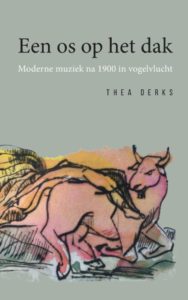An ox on the roof: Away from tonality (repeat). An introduction to contemporary music in everyday language.
Today, a repeat programme of the first episode of An ox on the roof by Thea Derks.
In September 2018, Thea Derks presented her book Een os op het dak: moderne muziek na 1900 in vogelvlucht (An ox on the roof: a brief sketch on modern music after 1900), an introduction to contemporary music written in everyday language. The first copy was presented to the British-Dutch composer Richard Ayres in Muziekgebouw aan ’t IJ in Amsterdam.
The book was very well received by the press and the public, and has since been sold throughout the Netherlands. In her programme ‘An ox on the roof’, she loosely follows the arguments of her book. Today, she zooms in on abandoning tonality.
For two centuries, approximately from the 18th to the 19th century, the western world composed according to the harmonic, also tonal, system. In this system, each scale has its hierarchy meaning that one tone is the most important; the so-called root tone or, in Latin language, ‘tonica’, which explains the term ‘tonal music.
Gradually, composers started to experience this system as restrictive and, in the early 20th century, Arnold Schönberg looked for ways to circumvent the gravitational force of the tonic. He decided to emancipate the ‘dissonant’ by equalizing all 12 semitones of the octave.
 Tip: if you buy the Ox through the website boekenbestellen.nl, you will receive a copy with a personal dedication.
Tip: if you buy the Ox through the website boekenbestellen.nl, you will receive a copy with a personal dedication.
1. Frederic Chopin. Etude in E, opus 10 nr. 3.
Vladimir Ashkenazy, piano.
2. Arnold Schönberg. Das Buch der hängenden Gärten.
Phyllis Bryn-Julson, soprano. Ursula Oppens, piano.
3. Darius Milhaud [zie foto]. Le boeuf sur le toit.
Orchestre de l’Opéra de Lyon conducted by Kent Nagano.
Composition, presentation and technique: Thea Derks








